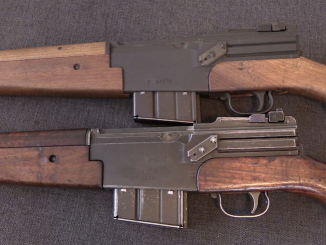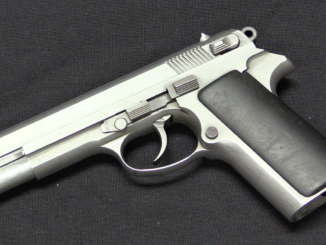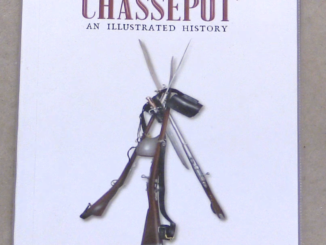Project Lightening is a collaborative series with Othais and Mae of C&Rsenal in which we test all seven light machine guns and automatic rifles of World War One and put them through a series of tests and evaluations. Each week we will be posting one video on Forgotten Weapons and one on C&Rsenal. Today we have the reloading comparison, and the TOTAL DAMAGE over on C&Rsenal:
Want to see the last two parts right now, instead of waiting until next week? You can download the entire series right now and have a permanent copy to keep for just $6 (all proceeds split between Forgotten Weapons and C&Rsenal):




The Lewis gun used a No.2 to change mags. The No.1’s main job was aiming/firing and clearing jams
You guys keep jumping the shark in these Lightening videos. Great that Mae figured out that you guys have the 08/15 bipod BACKWARDS for prone fire and it makes a dramatic difference. Also adding eight pounds to the 08/15 water jacket can help also. You finally point out that these are team weapons, even the Chauchats. Also when the Germans got down in hole they would switch to the 250 round belt. You claim that you are testing these guns in exceptional circumstances that in terms of strategic use, were non-existant. These guns required MANAGEMENT and TEAM TRAINING. Of course, you are using the portative tripod against bipod guns….the portative also had a stub under the barrel for a bipod. Watch you could have done was team up on these weapons to gain realistic data. It is of course fun seeing these guns shoot.
Let’s don’t get too critical just yet. What I see here is the machine guns getting fired in Hollywood conditions (which means everyone but the hero is dead). This is what most uninformed people expect to find when a historical war is mentioned. Games don’t make any more sense, especially when the light machine gun is treated as a one-person job with spare magazines or belts magically appearing from nowhere just for the players’ convenience!
The “management and team training” elements would greatly complicate this sort of testing. They explain that their intent is to show a “worst case scenario” and demonstrate any ergonomic deficiencies, which is probably a more accessible objective than hard-core “realism”.
It’s an old truth that LMGs get more hits per minute when fired semi. I’d like to see some tests using a witness sheet around (esp. above) the aiming mark. At longer ranges, full auto fire sends bullets amazingly high and wide. Semi auto, even with rapid triggering, keeps them much nearer — close enough to keep a lot of enemy heads down.
The new Mexico incident Ian mentions is not WWI, it’s the Pancho Villa raid pre-WWI.
Ian is correct. The raid took place in 1916. During WW1.
Aren’t you guys using inferior brass Japanese strips for the Portative?
Can we stop referring to Japan as inferior? The strips were suited to the role for which they were designed (a compromise between sustained-fire needs and portability, along with relatively easy production and maintenance). For your information, the reason that Japanese ammunition strips weren’t so great in build-quality was because American bombers targeted munition factories A LOT during the war, and even blew up schools in the ludicrous belief that ALL modern looking buildings in Japan were munition factories. It’s hard to make good ammunition and good guns when someone’s dropping incendiary bombs on your head 24/7. Plus, you’ve never been on the receiving end of Japanese machine gun fire, which was hardly inaccurate spray into the wild blue. If you pitted a bunkered-in Type 92 heavy machine gun against a single Marine out in the open armed with the M1 Garand WITH NO GRENADES AND NO RADIO TO CALL FOR ARTILLERY SUPPORT (as Hollywood usually arranges), I think the latter has a HUGE disadvantage.
My father bought an automatic Nissan Micra in about 1983, he said look at this its real Japanese this at the Datsun marked engine 1ltr… Took the family over Rhinos pass and everything; albeit at 1mph, parp parp it was called the car; and it lived for ages.
Ahem. Just saying…
“compromise between sustained-fire needs and portability, along with relatively easy production and maintenance”
[I would refer to Hotchkiss solution as trays for clarity]
It must be noted that trays were introduced no later than in Hotchkiss 1900, thus they are 19th century solution, at that time belts were canvas (non-metal), therefore trays were more humid-resistant and cold-resistant solution, however when metallic links were introduced (during Great War, see Prideaux patent) these traits could be also implemented in belt-fed weapons. However advantage of shorter pause of fire still does holds true. Kind of “mirror evolution” might be found during Great War, when lightened version of water-cooled machine guns were used with shorter belt and “semi-rigid” 251-belt was developed for Hotchkiss for usage in fortification and tanks (although any example of M1914 will accept that).
Regarding Japanese usage it is worth noting that when they adopted Hotchkiss machine gun at dawn of 20th century, they were heavily British-influenced in military area (see compare for example Mikasa battleship with HMS Majestic), despite that they chosen French weapon, thus probably they judged it better suited for environment in they were excepting to fight.
Sort of amusing but mostly pointless. I’ll keep watching.
I’m impressed with the skill demonstrated. I was issued the M60 and M249 while in the Army and National Guard and crew-served weapons can, with difficulty, be used as individual weapons. Good work!
Mae is probably at least as strong as First World War soldiers, especially when the latter had been in the trenches for more than a couple of weeks. She wasn’t laden down with packs and the other junk soldiers going “over the top” wore so that they’d be able to sustain themselves–but then Ian doesn’t carry several empty sand bags in addition to his other kit while competing in various matches, either.
https://encyclopedia.1914-1918-online.net/article/soldiers_equipment
I’ll stand by my earlier statements that the Chauchat and Browning Automatic Rifle were individual weapons, that the Lewis and Madsen could be efficiently handled by a crew of two, but the Hotchkiss and MG-08/15 require three men for efficient employment. The reloading tests demonstrated that–for the Hotchkiss and the Maxim, an “unloader” to help pull the spent feed strip or belt through the gun reduces malfunctions. The “unloader” can also help spot and adjust fire–as can the loader. Too bad there’s no resources to test reloading times with a full crew. It was pointed out that a loader on the Hotchkiss could clip additional feed strips on the strip in the gun while it was being fired, thus maintaining continuity of fire. Try that solo! Yes, it’s not practical while firing on the move, but then walking fire wasn’t really effective against disciplined troops dug in and camouflaged. The other reason for big crews of two or three was that all the junk and sufficient ammo could be carried by several–only the Browning Automatic Rifle and Chauchat could be managed by a single operator (the “assistant” for Chauchat and BAR was there mainly to take over the gun when the primary gunner became a casualty, then to carry extra ammunition–and was useful for spotting targets and calling out fire corrections–remember that the period sniper rifles were INDIVIDUAL weapons except in the British Army where a team of observer and sniper would usually work together).
As an aside, the Belgian Army used a 7.62x53mm Mauser cartridge and kept them into the early 1930’s.
Ommitted from above–the Belgian Army used a Chauchat in a 7.62x53mm Mauser cartridge and kept them into the early 1930’s.
True, but it must be noted that they replaced it with derivative of BAR 1918 namely D:
https://modernfirearms.net/en/machineguns/belgium-machineguns/fn-model-d-eng/
More generally BAR 1918 spawned more machine gun designs, than Chauchat, see Kg m/21
https://modernfirearms.net/en/machineguns/sweden-machineguns/kg-m21-m37-eng/
This doesn’t imply Chauchat is inferior, but that BAR 1918 had greater development potential.
“7.62x53mm Mauser cartridge”
Uhm, actual name is 7,65×53 mm (cartridge known as 7,65mm ARGENTINE in U.S. parlance)
Thanks, Daweo–I got the caliber wrong.
Mae is probably at least as strong as First World War soldiers, especially when the latter had been in the trenches for more than a couple of weeks.
I think Mae herself would certainly dispute that. She may have the advantage of 21st century nutrition overall, but WWI soldiers worked pretty strenuously every day — maintaining trenches when they were in them, and hauling supplies and ammunition when they were rotated out for “rest”. Historical soldiers may have been more tired than our industrious video heroes (even with the latter’s sleep deprivation), but I’m sure they had better muscle tone.
I’d like to know more about the people i watch every day…
Exept of toying around with guns in a state that allows you,making all of us jealous, what are your real occupations ? I mean, do you have a job, children to drive at school and to care about every day, wife to get on your nerves daily, do you shop in the super market like the people you present yourselves to and you ask for their support on purpose to dig up old empty shells or to travel around the world,etc , like if we ran out of FW ?
My god, at 11:30 I heard something I never though I would hear. Had to rewind it a couple times.
First my thanks and congratulations to you for this series – unprecedented and revelatory. Can we have more of the same please.
Somewhat as an aside to it. Do you (or anyone) have any idea as to how much these guns (particularly the Hotchkiss) cost at the time/WWI – I know it is somewhat crass when thinking of mens lives. But an important consideration, particularly in the pre war period and when they cost as much as medium machine guns (The Lewis 1912 £135 and 1915 £155-140 and the Madsen 1914 new £141, 1915 2nd. hand £152 and in Russia 1918 £183)
Apologies re my inadequate last post (showing my localist blinkers). The 1914 rate of exchange – £1 = $4.867 and this fairly constant until the end of WWI.
Speaking of loading a Lewis, you could have been a scout pilot in the RFC in the pre-synchronizer days, shooting a Lewis mounted on the top wing of your biplane. You reloaded yourself, hopefully not getting shot at at the time.
Some early RFC pilot whose name escapes me lost control of the plane when he attempted a reload: the empty drum jammed, and he spent some time HANGING FROM the drum while the plane went on straight and level but upside-down above him. (It was later determined that 2mm of bent metal kept him attached to the aircraft.) After some acrobatics he got his feet hooked into the cockpit, pulled the rest of himself in, righted the craft and flew home. He was written up and fined for damaging the instrument panel with his toes.
Mick Mannock, top UK ace, flew an SE5A with one synchronized Vickers and one Lewis on the top rail, this rail having an arrangement for pulling the gun back for reloading or shooting up. Mannnock crept up under an unsuspecting Hun flyer, pulled the Lewis back, and put one bullet through the pilot. “One shot, one kill.” Lewis = accurate, I guess, even at 100 mph.
Speaking of loading a Lewis, you could have been a scout pilot in the RFC in the pre-synchronizer days, shooting a Lewis mounted on the top wing of your biplane. You reloaded yourself, hopefully not getting shot at at the time.
Some early RFC pilot whose name escapes me lost control of the plane when he attempted a reload: the empty drum jammed, and he spent some time HANGING FROM the drum while the plane went on straight and level but upside-down above him. (It was later determined that 2mm of bent metal kept him attached to the aircraft.) After some acrobatics he got his feet hooked into the cockpit, pulled the rest of himself in, righted the craft and flew home. He was written up and fined for damaging the instrument panel with his toes.
Mick Mannock, top UK ace, flew an SE5A with one synchronized Vickers and one Lewis on the top rail, this rail having an arrangement for pulling the gun back for reloading or shooting up. Mannnock crept up under an unsuspecting Hun flyer, pulled the Lewis back, and put one bullet through the pilot. “One shot, one kill.” Lewis = accurate, I guess, even at 100 mph.
No one seems to remember that both McLean and Lewis were Americans and that Lewis was a serving soldier — thus good ergonomics and an easy-ish field-strip. Despite the strangeness of the coil spring it makes great sense as a delicate but easily-replaced part. USA practical thinking, not exceptionalism.
Glad you found it so – though if I thought like someone else. It would be more than a little weird and perhaps needing psychiatric help!
What are your particular interests / nuances re this subject. In the unlikely event that I could contribute anything. Then would happily do so e.g. niggling, wish I knew ………